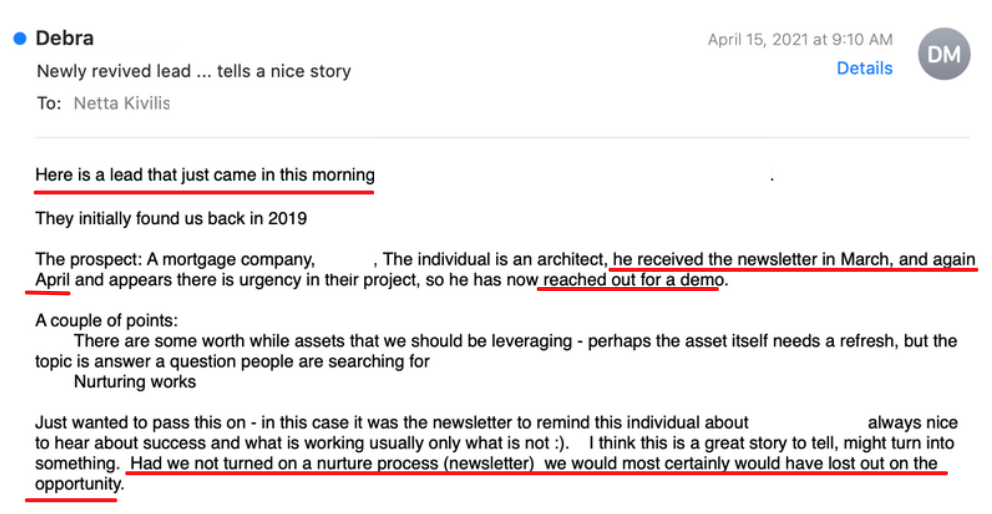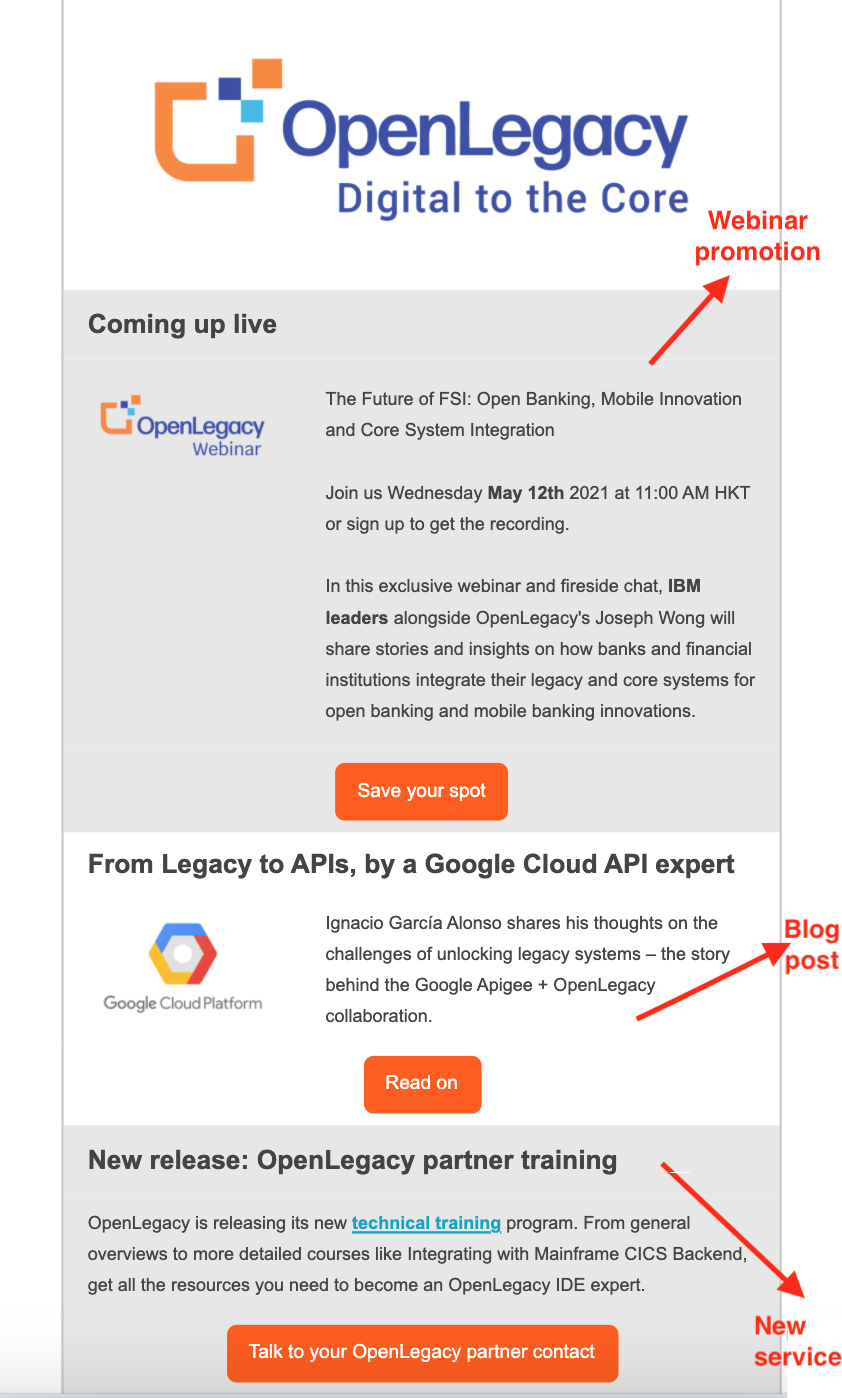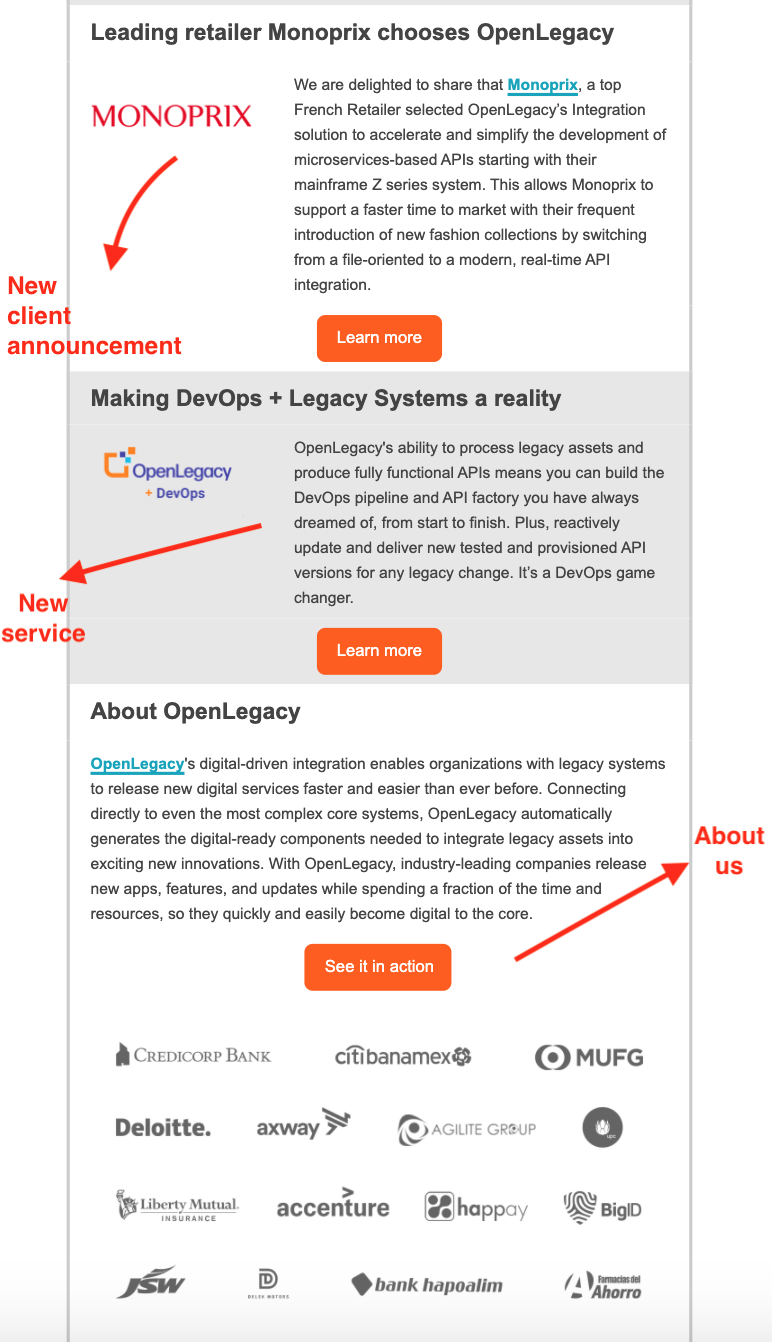Simply put, a newsletter is a regular email sent out to your database in a designed structure composed of images and text. There are many reasons we advocate for setting up a company newsletter early on in the life of a company: it is a relatively low-effort, low-cost affair that gives you the ability to consolidate different content into one single email, build credibility, establish a connection (and hopefully a conversation) with your contacts, and drive overall brand awareness. But the most important reason is that it allows you to fish and “catch” a prospect when they are ready to buy by keeping your brand top of mind.
Check out the feedback we recently got from a client about a prospect they “fished,” thanks to the newly implemented newsletter:

The prospect mentioned above converted to a paid pilot only 3 weeks after the initial call.
Below are our suggested 5 steps to plan, create, and execute a monthly or bi-weekly newsletter successfully:
1. Decide on a format
There are generally two routes you can take here:
- Using a templated/ designed, vertical newsletter with a healthy mix of content/text and images. We recommend you not go over 40%/60% image to text ratio for both aesthetic and deliverability reasons.
- Using a simple “Reader” style format which is mostly plain-text and image-free (but content rich) and feels more like a real human is behind the email.
If you have the bandwidth, you can (and should) experiment with both and determine which one is working best for you. It is worth noting that you don’t have to pick one over the other. We have clients that send out both of these types of newsletters on a monthly or quarterly basis.
2. Sourcing relevant, trustworthy content
The biggest obstacle (during the planning stage) is deciding what to include in your newsletter. The answer is: Anything that brings true value to your audience and speaks their language, with a small dose of selling/positioning of your brand. So…what exactly does that mean? Here are some options of what to include:
- Blog posts: If you are producing content you are proud of, a newsletter is a great way to share it. The nice thing is you don’t necessarily have to share new blog posts, feel free to recycle oldies but goodies, as long as they’re relevant (evergreen).
- Event promotion: Attending a conference you want to let others know you will be at? Running a webinar and hoping for more registrants? Announcing those here along with a call to action can bring visitors to your booth or viewers to your webinar. Make sure you can track the registration links you use here so you can attribute registrants to the newsletter.
- Client announcements: This is a great space and opportunity to announce your wins. Show off new clients you have convinced to buy from you—just remember to have full permissions on logo usage.
- Industry news: Curated industry news that is relevant to your brand and audience is always a great addition and will add appreciated diversity to your content selection.
- New product/service releases: If there is something new you are offering, a newsletter is a good place to flaunt it. Just remember to balance out your “salesy” content with lots of non-salesy content (we recommend roughly 75% non-salesy to 25% salesy).
- PR: If something [positive] has been published about your company, this is the perfect place to let it be seen.
- About us: We like to include this section at the end of image-and-text newsletters. This is a great opportunity to let your readers know your elevator pitch along with a cluster of logos of current and past customers.
Below is a sample newsletter with some of the content options mentioned above:


3. Maintaining a clean marketing database (and high deliverability rates)
“All lists should be considered dirty until proven otherwise.” – Erez Dafnai, Director of Marketing @ Blue Seedling
Make sure the list of folks you are planning to send your newsletter is clean and cleaned again every time you add to it. You want to keep your deliverability rates high for a myriad of reasons, the main one being sender reputation. In fact most email marketing platforms have a deliverability threshold you must pass before you find yourself getting into trouble.
- For the initial list sweep, we recommend using a service such as Kickbox which will classify your emails into 4 categories:
- Deliverable addresses
- Risky addresses
- Undeliverable addresses
- Unknown addresses
- We recommend sticking primarily to the addresses categorized as deliverable while using a small percentage of those categorized as risky (in order to validate Kickbox’s categorization). For the risky addresses you do decide to include, we recommend creating some safety measures (ex: retrieve only corporate domains, limited number of leads from each domain) to reduce the risk. Doing this will also allow you to “re-test” the addresses categorized as risky and determine if any are usable.
- Though you might be tempted to delete your hard bounced contacts, we are of the mindset you should simply unsubscribe them. Why you may ask? Because you might (accidentally) import that contact again after it has been deleted, which would inevitably force it to go through the same cycle of testing, sending and bouncing, which results in wasted resources. Having these problematic contacts on a master exclusion list is the best way to deal with them.
4. Quality Assurance
It is crucial to have both the author and an additional colleague go through a quality assurance checklist before hitting the send (or schedule) button. This will ensure a fresh pair of eyes dissects your email and double checks everything looks right, from links, to sender email address, to consistent capitalization and punctuation.
If you don’t want to make a mistake and accidentally email 60,000 unsubscribers, read our post on how to prevent it with a QA checklist.
5. Analyze performance
Roughly 48 hours after a newsletter is sent is a good time to review and record the performance metrics because most email activity happens in the first hours post-send.
Open rate, click-through rate, deliverability, click-to-open rate, bounce rate and total unsubscribers are the numbers we usually focus on. We often get asked what the industry standard is for these metrics, so check this MailChimp write-up out if you’d like to see where you stand in comparison to others, but take it with a grain of salt as the industries aren’t crisply defined and MailChimp skews very SMB (vs Enterprise).
Create a spreadsheet where you can record these metrics, so you can easily refer back to them and compare all the newsletter sends side-by-side. Check out our sample metrics template here.
The bottom line
Requiring minimal monetary and time investment, newsletters are a quick and easy win. The process of setting them up can seem daunting, but once you do it a couple of times, you will settle into a rhythm and dance your way through. And once you start seeing the fruits of your labor (bringing in leads), you’ll be racing to create next month’s.








